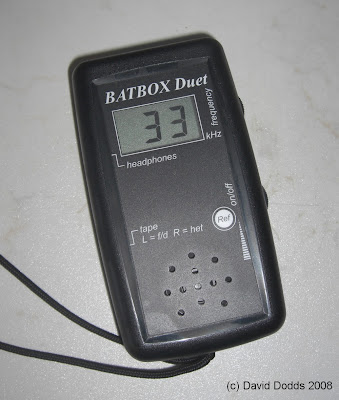 The most basic tool of the trade for a bat worker must be the heterodyne bat detector: the pocket-caculator look-alike that allows us to listen in to the sounds made by bats. Not only does it help us find bats, it often allows us to identify them to genus or species, to tell when they are feeding and to hear their social calls. It would be easy to be satisfied with that little lot, but the humble detector has other uses too.
The most basic tool of the trade for a bat worker must be the heterodyne bat detector: the pocket-caculator look-alike that allows us to listen in to the sounds made by bats. Not only does it help us find bats, it often allows us to identify them to genus or species, to tell when they are feeding and to hear their social calls. It would be easy to be satisfied with that little lot, but the humble detector has other uses too. Being pedantic, "bat detector" is the wrong name for the machine, as it implies that all you will hear on it are bats. This may stem from our tendency to talk about ultrasound as though it were something special and magical. In reality, ultrasound is simply sound above about 20kHz in frequency. The only thing that sets it apart from sounds below that frequency is the fact that one rather arrogant species with an abysmally poor hearing range can't hear it!
Many everyday things produce ultrasound: pouring water creates a loud noise around 40kHz. The standard test of whether a detector is switched on is to rub your fingers together in front of the microphone, a sound which is much louder around 45kHz than it is at frequencies within our hearing range. "Dry", rustling sounds tend to be much louder at higher frequencies: when our alsatian jumped into a huge pile of dead leaves behind me whilst I was using a detector with headphones, I though I was going to be deaf for life...
Bats aren't the only species which produce ultrasound. A common summer hedgerow sound is the high-pitched, furious squeaking of squabbling shrews. The lowest frequency of that call fall just withing our hearing range (older people may struggle to hear it at all), but on a bat detector tuned to about 20-40kHz they are very clear. In 2005 I and some colleagues from the BATML project were conducting a series of surveys along the towpath of the Union Canal. We kept hearing shrew sounds from one particular place by the water's edge. It was noticeable because these calls were extremely loud and unexpected. When you've had cause to swear loudly at something, it sticks in your mind! The Mammal Society were running their nationwide Water Shrew (Neomys fodiens) survey at the time, so I placed some tubes, baited with casters (blowfly pupae) and sure enough, the scats left in them were confirmed as having been left by a Water Shrew. This was particularly nice as it was the first record of this species from the Lothians for almost 20 years.
Another branch of natural history in which bat detectors are increasingly finding a place is in the study of Orthoptera: grasshoppers and crickets. It is possible to accurately identify them to species by listening to their sounds. Although many can be heard with the naked ear, they are clearer and louder when heard on a bat detector. Unlike bat (or shrew) calls, these sounds have no frequency variation, as they are stridulations, rather than calls, i.e. the sounds are made by rubbing legs together. Identification is made by listening to the rhythm of the sounds. As the insects tend to stay in one place whilst stridulating you can use the detector as a direction-finder to home in on them.
There's a good introduction to Orthoptera id using a bat detector on the web-site of the Environmental Records Centre for Cornwall and the Isles of Scilly (ERCCIS), along with a lot of other useful resources: http://www.erccis.co.uk/species/orthopteraaudio.htm
The Mammal Society's water shrew survey page: http://www.abdn.ac.uk/mammal/water_shrew_survey.shtml
The Bat Conservation Trust (BCT) website has a guide to choosing a bat detector. The models mentioned are mostly out of date now, but the technical advice is very sound: http://www.bats.org.uk/helpline/documents/Whichbatdetector.pdf
For what it's worth, I rate Bat-Box detectors as the best. They have the ideal balance of cost, effectiveness and sturdiness in the field. They're slightly cheaper if you buy direct: http://www.batbox.com/
My website: plecotus.co.uk
No comments:
Post a Comment